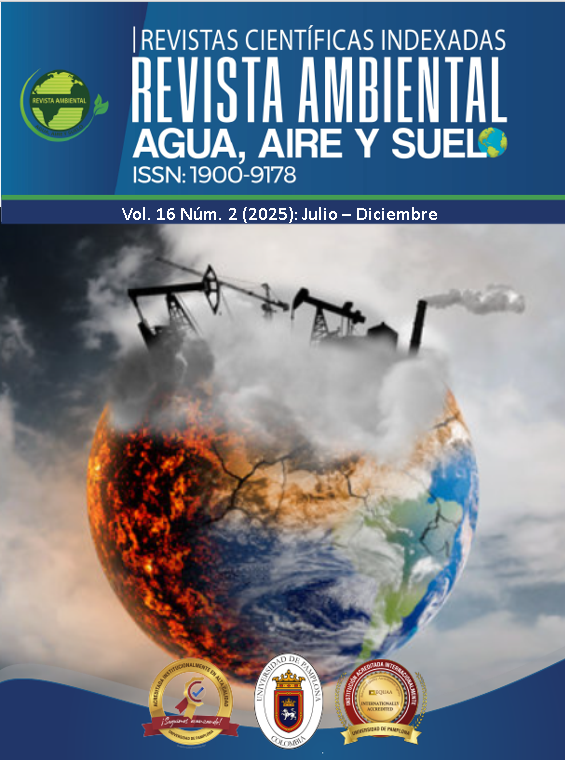LOW COST ROCKET ENGINEERING FOR AIR QUALITY STUDIES
DOI:
https://doi.org/10.24054/raaas.v16i2.4121Keywords:
Rocket, Aerodynamic design, Propulsion system, 7 to 10 kilometer altitude, Atmospheric variablesAbstract
Rockets reaching altitudes of 7 to 10 kilometers are gaining significant relevance today due to their multiple applications based on data recording and processing. One of the most important and relevant applications currently related to climate change is the recording of atmospheric variables at altitudes of 7 to 10 kilometers. Recording atmospheric data at these altitudes is important because it allows for studies in fields such as biometeorology and photobiology, and for analyzing the concentration of pollutants such as pesticides and insecticides to assess their impact on the environment and the population's lives. This work presents the results obtained in the rocket design for altitudes of 7 to 10 kilometers and also the recording of climatic variables (air quality, pollutants, and airflow). SpaceCAD software was used for the design and simulation of the rocket, and the GDL-propep model was used to model the engine thrust with data on the chemical composition of the propellant (KNO3/Sucrose 65/35). Variables such as threaded connections, combustion base, and a suitable nozzle were also taken into account. It is important to mention that the results showed a maximum thrust of 10,281.49 N and a minimum combustion chamber thickness of 2.6 mm. In conclusion, the proposed design meets the requirements necessary to achieve altitudes of between 7 and 10 kilometers and also measures atmospheric variables based on the selected sensors.
Downloads
References
Al-Garni, A. M., Al-Garni, S. A., Al-Jabali, K. A., & Al-Hamoud, A. H. (2023). Optimal trajectory of a sounding rocket using a direct pseudospectral method. Aerospace, 10(9), 785.
Ak, M. A., & Gencturk, M. O. (2023). Performance characterization and combustion properties of KNO3–sucrose solid propellant. Journal of the Brazilian Society of Mechanical Sciences and Engineering, 45(1).
Barrowman, J. (1966). The theoretical and experimental determination of the center of pressure of a model rocket. The National Association of Rocketry. https://www.nar.org/wp-content/uploads/2013/10/Barrowman-Method.pdf
Beer, F. P., Johnston, E. R., DeWolf, J. T., & Mazurek, D. F. (2023). Mechanics of materials (9th ed.). McGraw-Hill Education.
Budynas, R. G., & Nisbett, J. K. (2023). Shigley's mechanical engineering design (12th ed.). McGraw-Hill Education.
Cengel, Y. A., & Boles, M. A. (2023). Thermodynamics: An engineering approach (10th ed.). McGraw-Hill Education.
Chirania, A., & Singh, K. (2024). A review on composite solid rocket motor casings design and analysis. Materials Today: Proceedings, 102, 248–254.
Fortescue, P., Swinerd, G., & Stark, J. (Eds.). (2023). Spacecraft systems engineering (6th ed.). Wiley.
Heister, S. D., Anderson, W. E., Pourpoint, T. L., & Cassady, R. J. (2022). Rocket propulsion (2nd ed.). Cambridge University Press.
Hibbeler, R. C. (2022). Engineering mechanics: Dynamics (15th ed.). Pearson.
Jetson, J. O., & Ruffin, A. R. (2023). Advancements in conical nozzle aerodynamics for sounding rockets. Journal of Propulsion and Power, 39(2), 115–128.
Korkmaz, M. S., & Gumustakim, M. (2022). 6-DOF trajectory simulation of a sounding rocket and validation with flight data. Aircraft Engineering and Aerospace Technology, 94(7), 1083–1094.
Li, Z., Ren, W., Fan, C., Sun, W., & Li, R. (2023). Structural integrity and reliability analysis of solid rocket motor casings under high internal pressure. International Journal of Pressure Vessels and Piping, 201, 104845.
Metallic Materials Properties Development and Standardization (MMPDS) Handbook. (2024). MMPDS-18. Federal Aviation Administration.
Sutton, G. P., & Biblarz, O. (2022). Rocket propulsion elements (10th ed.). Wiley.
Vilas, A. D. (2022). Design and analysis of a supersonic sounding rocket for university-level competition. AIAA Propulsion and Energy Forum.
Downloads
Published
Versions
- 2025-08-03 (2)
- 2025-07-31 (1)
How to Cite
Issue
Section
License
Copyright (c) 2025 REVISTA AMBIENTAL AGUA, AIRE Y SUELO

This work is licensed under a Creative Commons Attribution-NonCommercial 4.0 International License.










